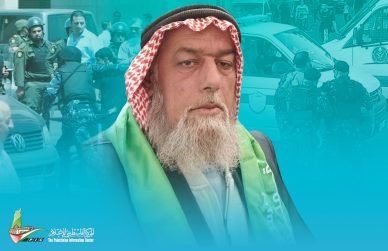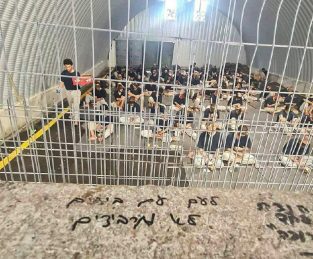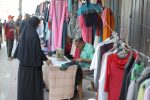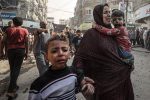GAZA, (PIC)
The Palestinian people commemorate Prisoner’s Day this year amidst the ongoing genocide carried out by the Israeli occupation forces in the Gaza Strip, and amidst major challenges facing the Palestinian cause.
Events and marches are taking place in Palestine, the diaspora, and around the world in support and solidarity with the prisoners, shedding light on one of the most prominent national issues.
One of the main objectives of the Al-Aqsa Flood operation on October 7th of last year was the liberation of the heroic prisoners from the Israeli prisons. The resistance captured dozens of Israelis in an attempt to free the largest number of prisoners.
According to international and local institutions concerned with prisoners’ affairs, the number of prisoners in the Israeli prisons reached approximately 9,500 prisoners, including 80 female prisoners and 200 children under the age of 18.
In a report obtained by the Palestinian Information Center, the institutions stated on the eve of Palestinian Prisoner’s Day that among the prisoners, there are over 3,660 administrative detainees and 56 journalists.
They also mentioned that the number of detained parliament members in the Israeli prisons is 17, most of whom are held under administrative detention, with the oldest being the prisoners Ahmad Sa’adat and Marwan Barghouti.
The institutions stated that these statistics do not include data on detainees from Gaza, as they are held under arbitrary detention so far. However, other reports indicate that the number of detainees from Gaza exceeds 3,000 prisoners.
The institutions pointed out that the only existing variable is that the Israeli occupation authorities and their various apparatuses have worked on developing more tools of torture and oppression. They have also deepened their violations through a deliberate escalation of violence aimed at breaking the will of the Palestinian prisoners and undermining any struggle to protect their human rights.
They also noted that the number of oldest-serving prisoners reached 21 after the martyrdom of prisoner Walid Daqqa. The oldest among them is the prisoner Mohammed Al-Taws from the town of Al-Jaba’a in Bethlehem, who has been imprisoned since 1985.
The number of prisoners serving life sentences is around 600, the most prominent of whom is the prisoner Abdullah Al-Barghouthi, sentenced to 67 life terms, followed by Ibrahim Hamed with 54 life terms.
Regarding the martyrs of the captive movement, the institutions indicated that the number has risen to 252 martyrs since 1967, after 16 prisoners were recently martyred inside the Israeli prisons. This does not include all the martyrs of the captive movement after the seventh of October, as the identities of the majority of the martyrs of the prisoners of Gaza who were martyred in the camps of the Israeli army are still concealed. The number of martyrs whose bodies are held by the occupation authorities is 27, the oldest of whom is the martyr Anis Dawlah, whose body has been held since 1980.
Unjust laws
Israel has employed unjust laws against prisoners, especially the law regarding the trial of children under the age of 14, the law to deprive them of education, and the law to withhold their financial entitlements. Perhaps the most dangerous of these is the law of forced feeding of hunger-striking prisoners.
Israel has also implemented the policy of detaining the bodies of prisoners who die in custody. Currently, it holds 496 bodies in refrigerators and in numbered graves, excluding the bodies of martyrs in the Gaza Strip after the war.
A bill to execute prisoners was proposed in 2015 but has not yet been approved by the Knesset, despite the public demand last November by extremist minister Itamar Ben-Gvir publicly calling for its approval.
However, Israel has not abandoned its high sentences. There are 561 prisoners serving life sentences and over 500 prisoners who have spent more than 20 years in prison, who are described as “generals of patience.” In addition, there are prisoners serving multiple life sentences, such as Abdullah Al-Barghouthi, sentenced to 67 life terms, and Nael Barghouthi, described as the oldest prisoner in the world, having spent 44 years in prison.
Even more dangerous than that is Israel’s policy of administrative detention, in which the indictment sheet is kept secret, and more than 3,660 prisoners are currently held under this illegal form of detention. The prisoner remains at the mercy of the Israeli intelligence, which governs and renews the prisoner’s detention without cause.
Multiple arrests
Experiences have shown that nothing deters the Palestinians due to their belief in the legitimacy of their struggle and their right to live freely on their land.
According to Fouad Al-Khafsh, a researcher on prisoners’ affairs, 75% of Palestinian prisoners have been re-arrested multiple times because they continue their struggle even after their release.
He added in an interview with Al-Jazeera that some prisoners are now being arrested for the 30th time, such as Sheikh Hassan Yousef, and for the 15th time, like prisoner Nazih Abu Aoun. Many of those currently detained by the occupation forces from various Palestinian factions and their leaders have been arrested multiple times, such as Marwan Barghouti, Ahmed Saadat, and Abbas Al-Sayed.
Prisoners have not been spared all means to assert their rights within prisons or even to liberate themselves. They have resorted to hunger strikes, with 26 collective strikes since 1967, in addition to hundreds of individual strikes.
Among these strikes is the Ashkelon prison strike in 1976, which lasted for 65 days, and the Nafha prison strike in 1980, which resulted in the martyrdom of four prisoners. The “Mother of Battles” strike in 1992 is one of the most famous, in which 7,000 prisoners participated, and one of them was martyred. The prisoners also carried out the “We Shall Live with Dignity” strike in 2012 and the “Dignity” strike in 2017.
The martyr Sheikh Khader Adnan inaugurated his hunger strike in 2011-2012, which lasted for 65 days, paving the way for modern individual strikes. He was followed by dozens of prisoners who went on strike for more than 100 days.
Israeli forces arrested hundreds of individuals in the Gaza Strip after October 7th, and considered them illegal combatants. Around 850 of them are still in captivity, and the occupation army has forcibly concealed any information about them. They are held in military camps near Gaza and secret prisons in the Negev, such as Sde Teyman and Eitam.
An Israeli military doctor revealed that some prisoners had lost limbs due to the prolonged shackles imposed on them for days and weeks. Israel has admitted to killing 27 Palestinians among the prisoners of Gaza.
Some female prisoners have also been forced to remove their hijabs, in addition to cases of harassment and strip searches.
The factions and families of prisoners agree that resistance is the only way to liberate the prisoners, as peace negotiations with Israel have not succeeded in freeing any of them.
This resistance lies in capturing Israeli individuals, especially soldiers, and engaging in exchange deals. Palestinian resistance has successfully achieved this in ten exchange deals between 1968 and 2011. These deals have been and remain the only hope for the prisoners to attain their freedom.
The most famous exchange agreements include the first Galilee Deal in 1983, the second known as the Ahmed Jibril Deal, the Popular Front – General Command in 1985, and the Wafaa Al-Ahrar (Loyalty of the Free) Deal in 2011. The Palestinian negotiator imposed his conditions in these deals, leading to the release of thousands of Palestinian prisoners, including those with high and life sentences.
The Al-Aqsa Flood came to revive the hopes of the prisoners, despite their pain due to the Israeli crimes in Gaza. Despite the pain, over 150 Palestinian prisoners, including children and women, regained their freedom in a partial deal that included the release of 50 Israeli women and children who were detained during the Al-Aqsa Flood.
Although many Israeli prisoners were killed as a result of the Israeli brutal bombardment of Gaza, the resistance continues to negotiate for those who remain, and the Palestinians, especially the prisoners, pin their hopes on that.
Researcher Al-Khafsh explains that negotiations and the peace process have not released a single prisoner. Those released by Israel after the Oslo Agreement were under the pretext of good intentions towards the Palestinian Authority’s return to negotiations. In 2013, Israel released 75 prisoners out of 104 who were arrested before Oslo. While some of them were liberated or martyred, 22 of them remain to this day, known as the Fourth Batch Prisoners, most of whom are from the occupied territories of 1948.
The escapes from the occupation prisons were another hope for prisoners, many of which succeeded, most recently in September 2021, when 6 of the prisoners of Gilboa prison managed to escape by digging a tunnel beneath the prison, but the occupation forces found them and rearrested them after several days in which they tasted freedom.















